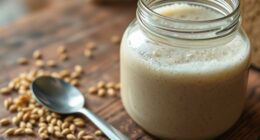Understanding whether your reaction is controlled by kinetic or thermodynamic factors depends on the conditions you set. If you focus on low temperatures and quick reaction times, you’ll favor kinetic control, producing products formed fastest but not the most stable. Higher temperatures and longer durations allow the system to reach equilibrium, giving thermodynamic control, which yields the most stable products. To optimize your reaction, considering these factors is key—continue exploring to learn how to manipulate conditions effectively.
Key Takeaways
- Kinetic control favors the fastest-forming product with lower activation energy, typically at lower temperatures.
- Thermodynamic control favors the most stable product, achievable under higher temperatures and longer reaction times.
- Reaction conditions like temperature and time determine whether kinetics or thermodynamics dominate.
- Kinetic products form quickly but may be less stable; thermodynamic products are more stable but form more slowly.
- Adjusting reaction parameters guides the process toward either kinetic or thermodynamic control for desired outcomes.
Understanding the Basics of Reaction Control
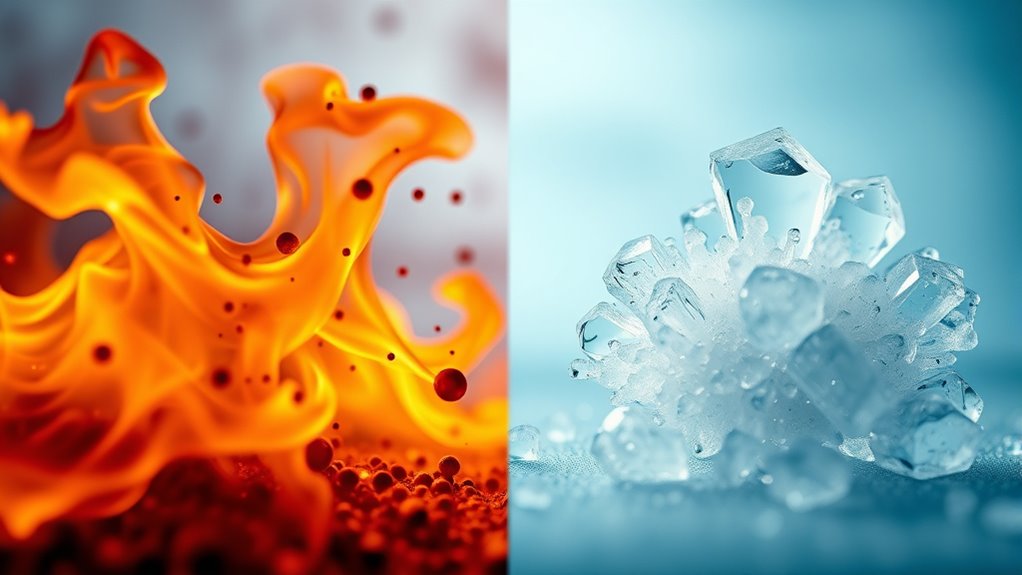
Understanding reaction control begins with recognizing how reactions are directed toward specific products based on conditions and time scales. When you control the reaction environment, you influence whether kinetic or thermodynamic products form. A comprehensive understanding of historical farmhouses by region and their preservation efforts can inform approaches to chemical stability and reaction pathways. Reaction pathways can vary, with some favoring quick, less stable products, while others allow the system to settle into the most stable state. By adjusting factors like temperature and reaction duration, you steer the process toward the desired outcome, understanding that reaction conditions fundamentally dictate which control dominates.
Key Differences Between Kinetic and Thermodynamic Products
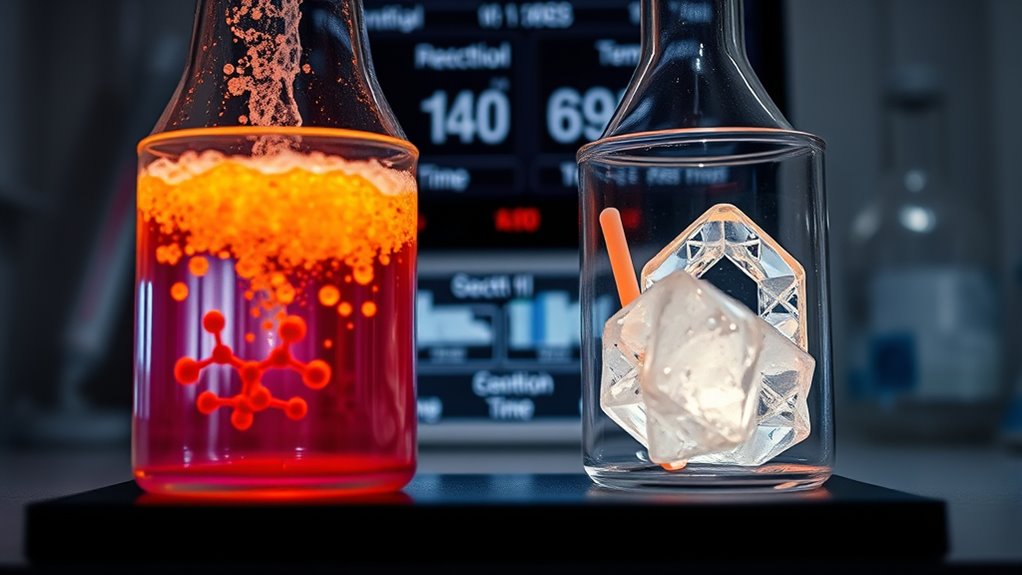
The key differences between kinetic and thermodynamic products lie in how they form and their stability. Kinetic products form rapidly due to lower activation energies, usually at lower temperatures, resulting in less stable, often terminal, double bonds. They tend to form quickly and are often irreversible. Understanding reaction pathways helps explain why these products dominate under specific conditions. Additionally, the reaction conditions, such as temperature and reaction time, significantly influence which product is favored, with reaction conditions playing a crucial role. Changes in reaction environment can shift the balance between kinetic and thermodynamic control, affecting the overall outcome of the reaction. Thermodynamic products develop more slowly but are more stable because they’ve more substituted, internal double bonds, which are stabilized by resonance and hyperconjugation. These products are favored at higher temperatures and longer reaction times, allowing reversible steps.
Structurally, kinetic products have fewer alkyl groups and less resonance stabilization, while thermodynamic products feature more substitution and greater stability.
Energy profiles show kinetic products as local minima, with lower activation barriers, and thermodynamic products as global minima, with lower overall energy.
How Reaction Conditions Influence Control Mode
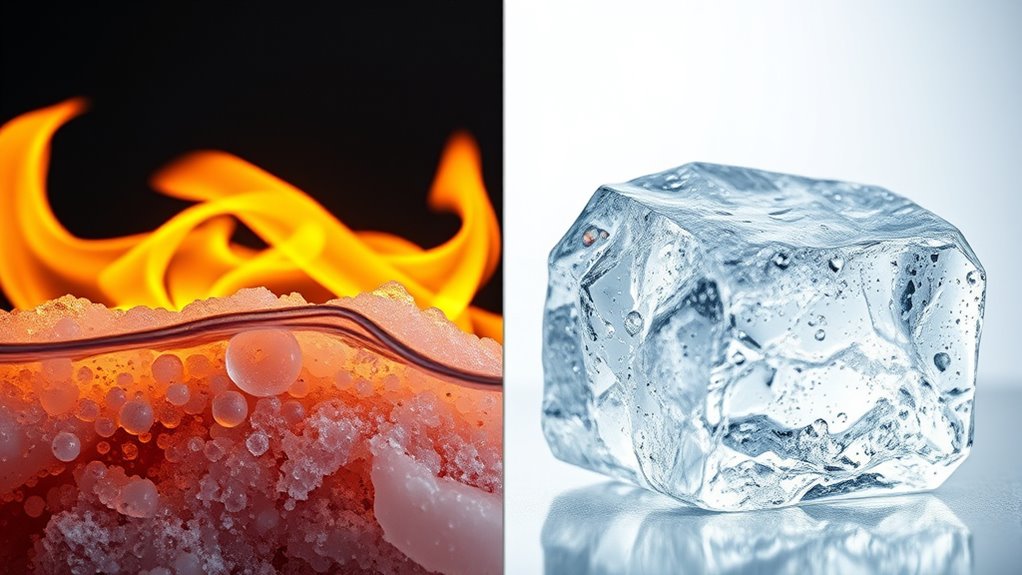
Reaction conditions such as temperature, pressure, solvent choice, and catalysts play a crucial role in determining whether a reaction proceeds under kinetic or thermodynamic control. Lower temperatures tend to favor kinetic control because they slow down the reaction, favoring faster-forming products. Higher temperatures promote thermodynamic control by allowing the system to reach equilibrium, favoring the most stable products. Elevated temperatures increase reaction rates and product stability, shifting the outcome toward thermodynamic products. Understanding reaction pathways helps predict which control mode will dominate under specific conditions. Additionally, the reaction mechanism itself can influence whether kinetic or thermodynamic products are favored by determining the energy profile of the pathway. The energy landscape of a reaction can also provide insights into which products are more likely to form under different conditions. Pressure influences reaction pathways mainly in gas-phase reactions and can alter product distribution by shifting equilibria. Solvent choice affects reaction pathways through stabilization of intermediates and solubility, impacting control mode. Catalysts can steer reactions toward kinetic or thermodynamic products by influencing reaction pathways and energy barriers.
Energy Profiles: Pathways to Products
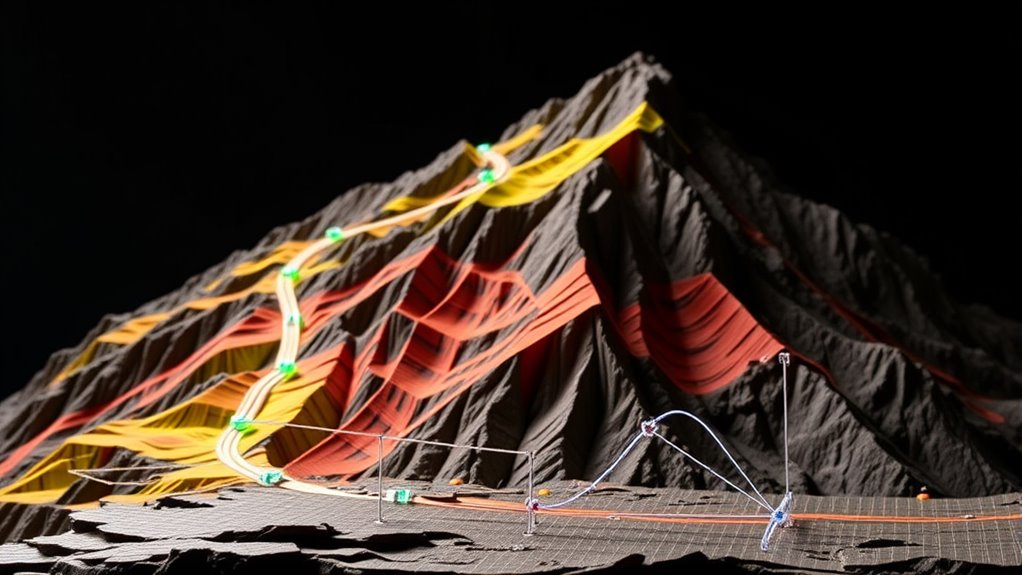
Energy profiles map out the journey from reactants to products by illustrating the changing energy levels throughout a reaction. They show your starting point, the reactants, and the endpoint, the products, along with the energy differences between them. The highest point on the graph, the transition state, indicates where bonds break and form. This peak reflects the energy barrier your reaction must overcome. For exothermic reactions, products are lower in energy than reactants, while endothermic reactions have higher-energy products. Multistep reactions feature multiple peaks, each representing an intermediate step. By visualizing these pathways, you can identify the most favorable route for your reaction. Additionally, understanding the contrast ratio helps in optimizing the conditions under which the reaction occurs, ensuring clearer observation of the energy changes. Recognizing the influence of spiritual energy can also provide a metaphorical perspective on how energy flows influence the overall reaction pathway. Energy profiles provide valuable insights into the reaction’s thermodynamics and help you understand how energy changes shape the pathway to products.
The Role of Activation Energy in Product Formation
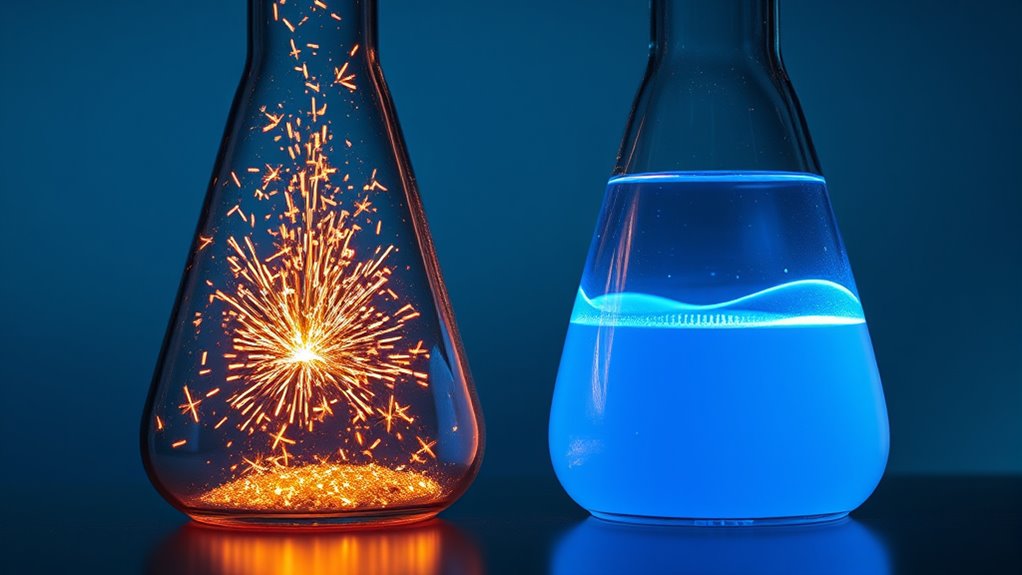
Activation energy, often represented as (E_a), determines how quickly a chemical process occurs by setting the energy threshold that reactants must overcome to form products. When (E_a) is low, more molecules have enough energy to react, speeding up product formation.
Conversely, high activation energy acts as a barrier, slowing the reaction or requiring additional energy like heat. Temperature influences this process by increasing molecular kinetic energy, helping reactants surpass (E_a).
Catalysts play a crucial role by lowering the activation energy, allowing reactions to proceed faster without extra heat. Understanding (E_a) helps you predict reaction rates and design efficient processes.
A lower activation energy means a quicker, more feasible reaction, directly impacting how and when products form.
Reversibility and Equilibration in Reaction Control
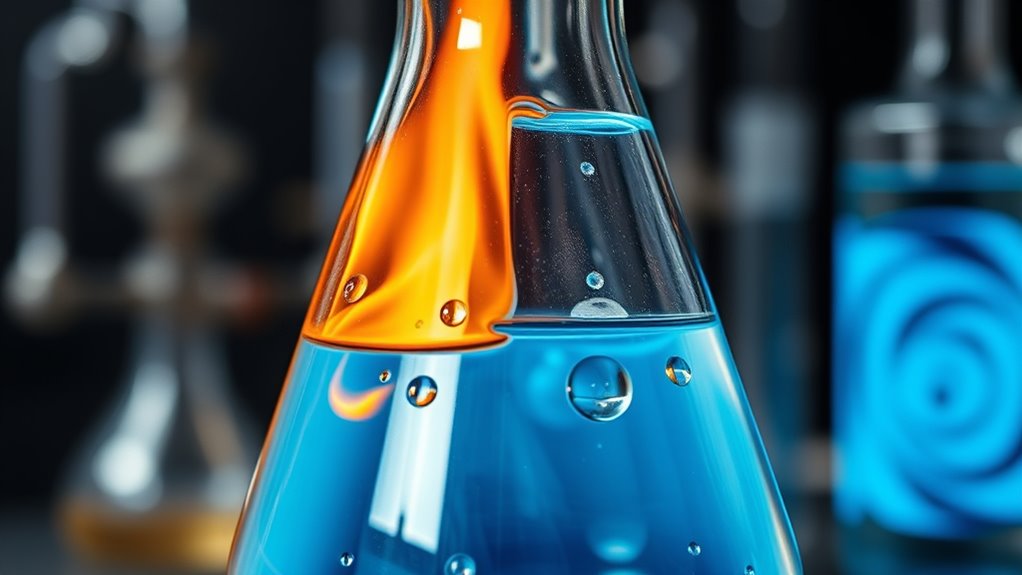
Reversible reactions are characterized by the simultaneous conversion of reactants into products and vice versa, meaning the process can proceed in both directions. When this happens, the reaction reaches a dynamic equilibrium where forward and reverse rates are equal, and concentrations remain constant.
Even at equilibrium, molecules continue to convert, but overall, there’s no net change in reactant or product amounts. The time needed to reach this point depends on reaction rates and conditions like temperature.
Reversibility allows reactions to respond to changes, shifting the equilibrium position according to Le Chatelier’s Principle. This balance between kinetic and thermodynamic factors determines whether the outcome favors products or reactants, emphasizing that reversibility plays a crucial role in controlling reaction pathways and final distributions.
Practical Examples of Kinetic and Thermodynamic Control
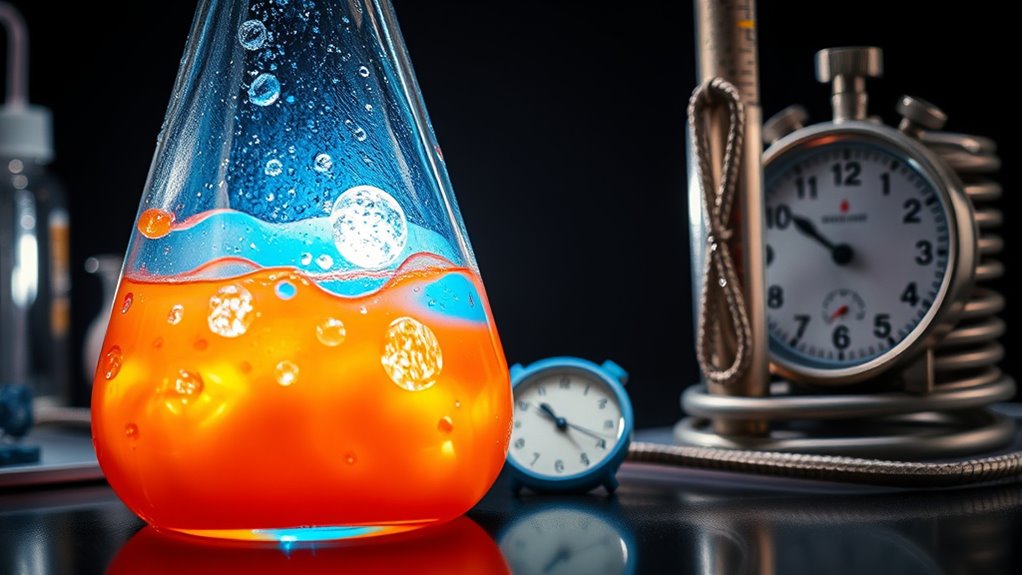
Understanding the practical differences between kinetic and thermodynamic control is essential when designing reactions in organic synthesis.
For example, the Diels-Alder reaction favors the *endo* product kinetically at low temperatures due to a lower activation energy. In contrast, longer reaction times or higher temperatures often yield the more stable *exo* product, demonstrating thermodynamic control.
Addition reactions, like HCl with butadiene, can produce different products depending on conditions: rapid, low-temperature processes favor kinetic products, while extended heating leads to thermodynamic ones.
Catalytic systems, especially in enantioselective synthesis, typically operate under kinetic control to produce specific enantiomers.
Reaction conditions, including solvent choice and temperature, directly influence whether kinetic or thermodynamic pathways dominate, impacting product formation and stability.
Manipulating Conditions to Favor Desired Products
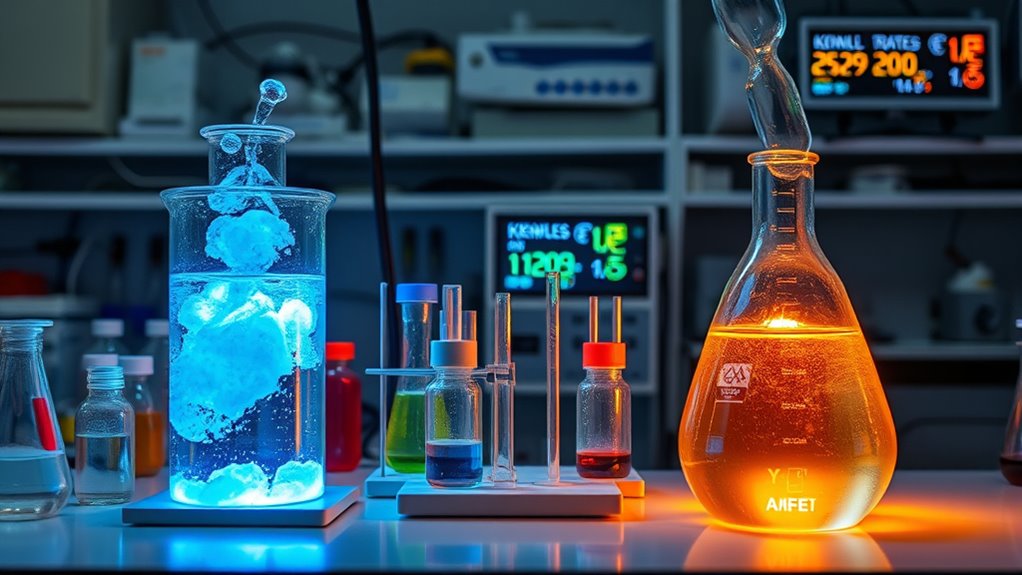
Adjusting reaction conditions allows you to steer the outcome toward either kinetic or thermodynamic products. Lower temperatures favor kinetic control by limiting molecular energy, preventing rearrangements, and locking in the first-formed products. Rapid cooling can “freeze” these kinetic products before they convert. Short reaction times also promote kinetic control, as products form faster than they can equilibrate.
Conversely, higher temperatures increase molecular energy, enabling reversible reactions that lead to the most stable, thermodynamic products. Longer reaction times and elevated temperatures allow the system to reach equilibrium, favoring thermodynamic control.
Additionally, changing solvents and medium effects can influence activation energies and reversibility, while pressure and concentration adjustments can shift equilibria. By manipulating these conditions, you direct your reaction toward the desired kinetic or thermodynamic outcome.
Mechanistic Factors That Determine Control Mode

The pathway a reaction takes is largely determined by mechanistic factors such as activation energy differences and energy barriers. If a pathway has a lower activation energy, you’ll form the kinetic product faster, even if it’s less stable.
Conversely, pathways with higher activation energies lead to the thermodynamic product, which is more stable but forms more slowly. Reactions under kinetic control favor the route with the lowest energy transition state, regardless of product stability.
When activation energies are similar, other factors like reversibility influence product distribution. Irreversible steps lock in kinetic products, while reversible steps allow equilibration, favoring the most stable thermodynamic product.
Temperature and reaction time also play roles, affecting whether kinetic or thermodynamic control dominates based on energy barriers and mechanistic pathways.
Choosing the Right Control Strategy for Your Reaction
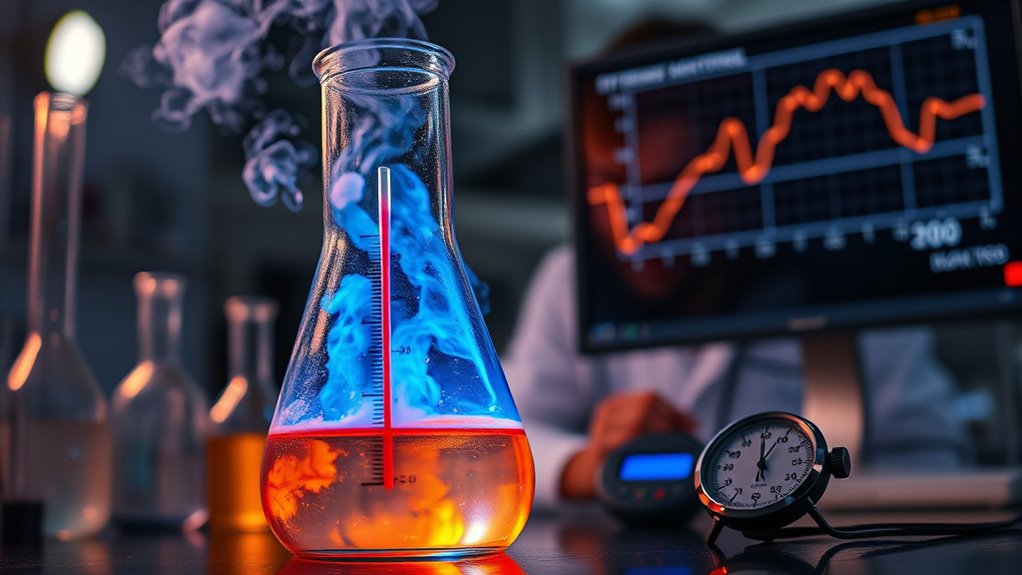
Choosing the appropriate control strategy for your reaction depends on the conditions under which it occurs. If you want kinetic control, lower temperatures help by slowing reactions and emphasizing pathways with lower activation energies. Short reaction times prevent equilibration, preserving less stable products.
Solvents and catalysts can also influence the reaction rate and selectivity, favoring kinetic products when needed. Conversely, for thermodynamic control, higher temperatures and longer reaction times allow the system to reach equilibrium, favoring the most stable products.
Reversibility and conditions that promote equilibration are essential here. By understanding your reaction’s energy barriers, stability, and conditions, you can select a strategy that maximizes yield and selectivity, aligning with your desired outcome—whether it’s kinetic or thermodynamic control.
Frequently Asked Questions
Can a Reaction Switch From Kinetic to Thermodynamic Control During the Process?
You might wonder if a reaction can switch from kinetic to thermodynamic control during the process. Yes, it can.
Initially, the fastest-forming product dominates, but as you increase temperature or reaction time, reversible steps allow the system to reach equilibrium.
This shift enables the more stable, thermodynamic product to form, especially when conditions favor reversibility, allowing the reaction to evolve from kinetic to thermodynamic control.
How Do Catalysts Influence Whether a Reaction Is Kinetically or Thermodynamically Controlled?
Imagine standing at a crossroads in a reaction, unsure which path leads to your goal. Catalysts come into play here, secretly guiding you.
They speed up reactions by lowering activation energy, making certain pathways more accessible.
While they don’t change the overall energy or equilibrium, they determine if your reaction proceeds quickly (kinetic control) or favors the most stable product (thermodynamic control).
Their influence shapes your reaction’s outcome dramatically.
What Role Does Solvent Choice Play in Reaction Control?
You should consider how solvent choice impacts your reaction control. A polar protic solvent stabilizes charged intermediates, favoring ionic pathways and possibly kinetic control.
In contrast, a non-polar solvent stabilizes radicals, promoting different pathways.
By selecting the right solvent, you can influence reaction rates, intermediates, and product stability.
This strategic decision helps you steer the reaction toward a desired outcome, whether faster formation or more stable products.
Are Kinetic or Thermodynamic Products More Desirable in Pharmaceutical Synthesis?
Did you know that nearly 80% of pharmaceuticals rely on kinetic control to produce specific stereochemistry?
When choosing between products, it depends on your goal. Kinetic products form faster and can give you the desired shape or activity, making them essential for certain drugs.
Thermodynamic products are more stable, ideal for long-term storage.
Your decision hinges on whether you prioritize quick formation or stability for your pharmaceutical application.
How Can Reaction Time Be Optimized to Favor the Desired Control Mode?
You can optimize reaction time by carefully monitoring how quickly your reaction reaches desired products. Shorten the time to favor kinetic control, preventing the system from reaching equilibrium, while extending it allows thermodynamic products to form.
Adjust parameters like temperature, catalyst, and reactant concentrations accordingly. Using in situ kinetic studies and kinetic modeling helps you identify the ideal timing, ensuring you get the product you want efficiently.
Conclusion
Ultimately, understanding whether your reaction is governed by kinetics or thermodynamics is like steering a ship through different waters—you need the right map and tools. By adjusting conditions and recognizing the energy pathways, you steer toward your desired product. Remember, it’s not just about the fastest route but the one that leads to your destination. Mastering this balance turns your chemistry journey from a stormy voyage into a smooth sailing adventure.









